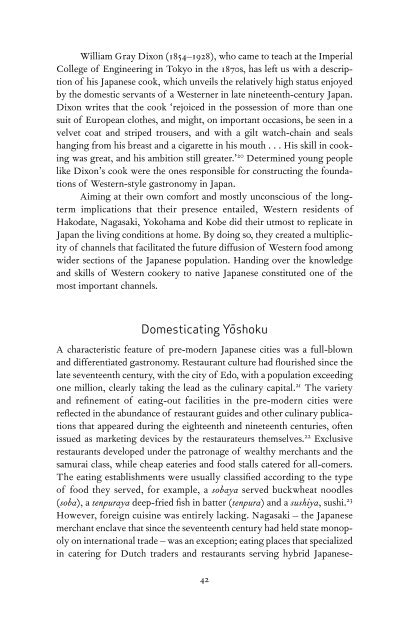Download - Brainshare Public Online Library
Download - Brainshare Public Online Library
Download - Brainshare Public Online Library
Create successful ePaper yourself
Turn your PDF publications into a flip-book with our unique Google optimized e-Paper software.
William Gray Dixon (1854–1928), who came to teach at the Imperial<br />
College of Engineering in Tokyo in the 1870s, has left us with a description<br />
of his Japanese cook, which unveils the relatively high status enjoyed<br />
by the domestic servants of a Westerner in late nineteenth-century Japan.<br />
Dixon writes that the cook ‘rejoiced in the possession of more than one<br />
suit of European clothes, and might, on important occasions, be seen in a<br />
velvet coat and striped trousers, and with a gilt watch-chain and seals<br />
hanging from his breast and a cigarette in his mouth . . . His skill in cooking<br />
was great, and his ambition still greater.’ 20 Determined young people<br />
like Dixon’s cook were the ones responsible for constructing the foundations<br />
of Western-style gastronomy in Japan.<br />
Aiming at their own comfort and mostly unconscious of the longterm<br />
implications that their presence entailed, Western residents of<br />
Hakodate, Nagasaki, Yokohama and Kobe did their utmost to replicate in<br />
Japan the living conditions at home. By doing so, they created a multiplicity<br />
of channels that facilitated the future diffusion of Western food among<br />
wider sections of the Japanese population. Handing over the knowledge<br />
and skills of Western cookery to native Japanese constituted one of the<br />
most important channels.<br />
Domesticating Yōshoku<br />
A characteristic feature of pre-modern Japanese cities was a full-blown<br />
and differentiated gastronomy. Restaurant culture had flourished since the<br />
late seventeenth century, with the city of Edo, with a population exceeding<br />
one million, clearly taking the lead as the culinary capital. 21 The variety<br />
and refinement of eating-out facilities in the pre-modern cities were<br />
reflected in the abundance of restaurant guides and other culinary publications<br />
that appeared during the eighteenth and nineteenth centuries, often<br />
issued as marketing devices by the restaurateurs themselves. 22 Exclusive<br />
restaurants developed under the patronage of wealthy merchants and the<br />
samurai class, while cheap eateries and food stalls catered for all-comers.<br />
The eating establishments were usually classified according to the type<br />
of food they served, for example, a sobaya served buckwheat noodles<br />
(soba), a tenpuraya deep-fried fish in batter (tenpura) and a sushiya, sushi. 23<br />
However, foreign cuisine was entirely lacking. Nagasaki – the Japanese<br />
merchant enclave that since the seventeenth century had held state monopoly<br />
on international trade – was an exception; eating places that specialized<br />
in catering for Dutch traders and restaurants serving hybrid Japanese-<br />
42







